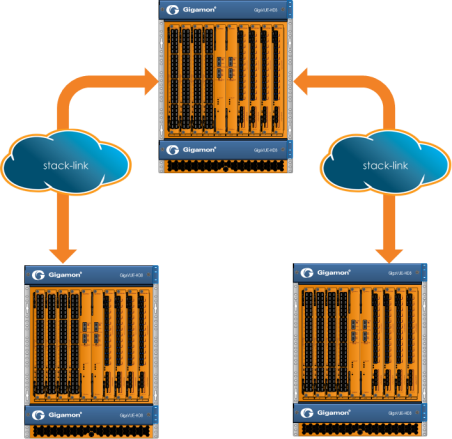stack-link
Required Command-Line Mode = Configure
Use the stack-link command to create a stacking connection between two GigaVUE nodes in a cluster. Stack-links carry traffic from network ports on one node to tool ports on a destination node.
With out-of-band clustering, cluster control traffic is carried out-of-band on its own network either over the dedicated cluster Management port (eth2) or the Mgmt port (eth0). With inband clustering, cluster control traffic is carried inband through the stack-link.
Note: Refer to the “Creating and Managing Clusters” section in the GigaVUE Fabric Management Guide for details on configuring a cluster.
Stack-links can be constructed out of individual stack ports (for example, a 40Gb port on a PRT-H00-Q02X32 line card), or, more commonly, stack GigaStream. You decide which to use with the gigastream and ports arguments in the stack-link command. For example, the following command creates a stack-link between the q1 40Gb port on box 1/slot 1 and the q2 port on box 2/slot 7:
(config) # stack-link alias biglink between ports 1/1/q1 and 2/7/q2 comment “40Gb Stack”
Stack links are supported at speeds of 10Gb, 40Gb, and 100Gb. Refer to the Hardware Installation Guide for each GigaVUE node for information on stack link support.
Keep in mind that because of the10Gb port density offered by the GigaVUE‑OS nodes, using only one 10Gb port for a stack-link could cause a serious bottleneck. A stack GigaStream dramatically increases the bandwidth available for stack-links, letting you connect GigaVUE nodes in a cluster and still take advantage of the 10Gb port density. Alternatively, nodes with 40Gb or 100Gb ports can take advantage of their high bandwidth for stack-links.
When using stack GigaStream for stack-links, you must create a stack GigaStream on each side of the stack-link and each side must consist of the same number of ports running at the same speed.
The stack-link command is also used as part of the configuration of the leaf and spine architecture with multiple paths for achieving high availability in a cluster environment. Refer to the “Multi-Path Leaf and Spine” chapter in the GigaVUE Fabric Management Guide for details.
The following figure shows a simple cluster with stack-links between the nodes.

The stack-link command has the following syntax:
stack-link alias <stack alias>
between <gigastreams <stack-link gigastream> and <stack-link gigastream>> |
<<ports <stack-link port> and <peer stack-link port>>
comment <comment>
The following table describes the arguments for the stack-link command:
|
Argument |
Description |
|
stack-link alias <stack alias> |
Specifies an alias for the stack-link. |
|
between <gigastreams <stack-link gigastream> and <stack-link gigastream>> | <<ports <stack-link port> and <peer stack-link port>> |
Specifies the two sides of the stack-link, either between GigaStream or between ports. For example: (config) # stack-link alias biglink between ports 1/1/q1 and 2/7/q2 You can also edit regular stack GigaStreams that are configured on either sides of a stack link. When a stack GigaStream is attached to a map, you can add or delete stack ports from the stack GigaStream. For example: (config) # stack-link alias stkN2toN4 between gigastreams N2toN4 port-list 2/1/c2x1..c2x3 and N4toN2 port-list 4/1/x1..x3 |
|
comment <comment> |
Adds a comment to a stack-link. Comments can be up to 128 characters. Comments longer than one word must be enclosed in double quotation marks for example: (config) # stack-link alias biglink comment “40Gb Stack” |
Related Commands
The following table summarizes other commands related to the stack-link command:
|
Task |
Command |
|
Displays all stack-link connections. |
# show stack-link |
|
Displays a specified stack-link connection. |
# show stack-link alias hc3-to-ta10-4 |
|
Displays all stack-link connections. |
# show stack-link all |
|
Displays all stack-link connections in a table format. |
# show stack-link brief |
|
Deletes a specified stack-link. |
(config) # no stack-link alias hc3-to-ta10-4 |
|
Deletes all stack-links. |
(config) # no stack-link all |



